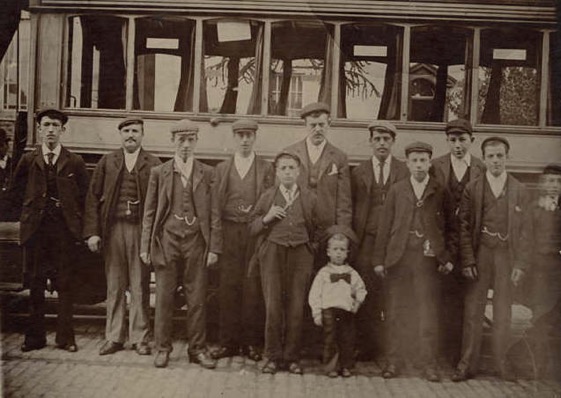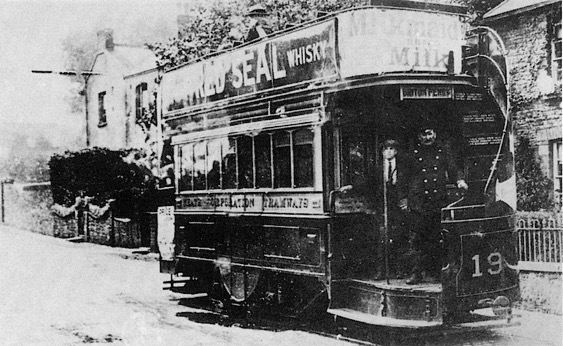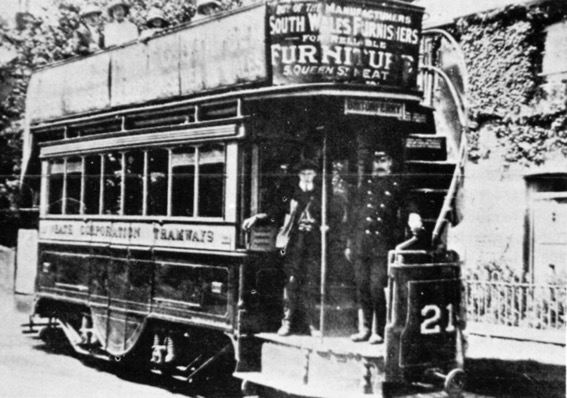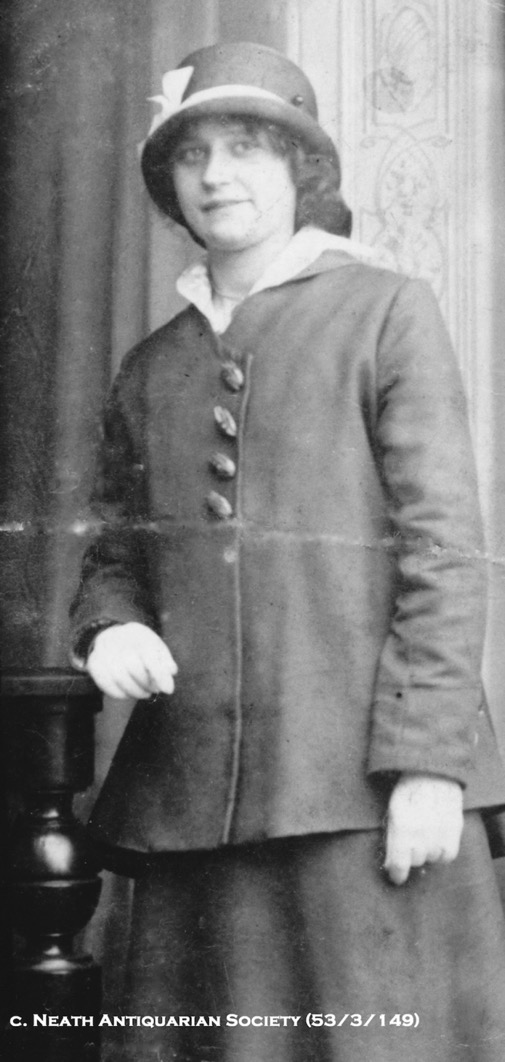Neath Corporation Tramways
History
Neath Corporation informally became a tramway owner on the 7th August 1896, when the Neath Tramway Syndicate, which was acting on its behalf, purchased the assets of the Neath and District Tramways Company Limited, the owners of a 3.96-mile long, standard gauge horse-drawn tramway that ran from Skewen eastwards to Neath, then southwards to Briton Ferry on the east bank of the River Neath.
The Neath Tramway Syndicate operated the line until such time as the corporation obtained the necessary powers, both to operate the system and to reconstruct it. The required act was passed into law in June 1897, following which the council presumably took over (this is not wholly clear). The corporation was evidently keen to lease whatever new system it decided to build, and with this in mind. solicited proposals for its consideration. Although three offers were received, including one from the British Electric Traction Company, the council's Tramways Committee somewhat surprisingly (in August 1897) chose to recommend that of the British Gas Traction Company. The latter company, which had been set up on the 13th July 1896, held various patents based on technology developed by Carl Lührig in Germany, and was at the time the leasing decision was made, operating two other British tramways using gas traction (see below).
Although the BGTCo had signed the lease, problems started almost immediately, the company seemingly being unable to procure the trams needed to commence a service, and blaming the corporation for not having laid a gas supply to the depot. The latter problem ought to have been easily remedied, so the delay in starting services, which became protracted, almost certainly reflected a deeper malaise within the BGTCo. In the event, the corporation forced the company to provide a horse tram service (possibly from April 1898, this is unclear), which it seems to have done for over a year, the last horse tram running on the 29th August 1899, and the first gas-tram services starting two days later on the 31st August 1899.
With hindsight, it seems astonishing that the corporation leased the system to the BGTCo, given that the latter had been struggling mightily with the technology since the 11th July 1896, when it began operating gas trams under a lease arrangement for the Blackpool, St Annes and Lytham Tramways Company. After two years of strenuous effort (the gas trams were unreliable and badly under powered), the BGTCo found itself in severe financial straits, which would finally end up with the company entering liquidation (on the 1st November 1899), barely two months after gas tram operations had commenced in Neath.
Whilst the BGTCo assets and interests in its two other tramways at Trafford Park (Manchester) and Blackpool were quickly sold (probably in early November 1899), the company appears to have continued to run the trams in Neath whilst in liquidation. This unsatisfactory state of affairs was finally resolved in 1902 when the tramway's manager set up a new company — the Neath Gas Traction Company — and took over the lease (around July 1902). By the end of the year, this new concern had been retitled the Provincial Gas Traction Company.
The PGTCo operated services for the next fourteen years, though not without much public criticism, mainly around the unreliability of services and severe over-crowding. Although the company's lease was renewed in 1912, the corporation was far from satisfied, having unsuccessfully attempted to buy the company's assets and work the system itself, but baulking at the company's asking price. By 1916 however, the PGTCo was on the ropes and could no longer continue, surrendering the lease to the corporation, which then worked the system itself from the 10th June 1916.
The system was in extremely run-down condition by the end of the Great War, and with significant investment required, it was perhaps inevitable that the tramway would be closed. Whilst the corporation deliberated whether to convert the system to electric traction, the announcement — by the South Wales Transport Company — that they would start running buses over the route of the tramway from the 9th August 1920, caused the corporation to throw in the towel, no doubt putting them and the long-suffering Neath public out of their collective misery. The last gas tram, in fact the last revenue-earning gas-powered tram service in the world, ran for the final time on the 8th August 1920.
Uniforms
No photographs have survived that unequivocally show the circa 14-month period during which the BGTCo operated the system using horse traction. However, a photo below with a newly delivered gas tram (presumably not yet in service) shows all present to be wearing informal attire, suggesting that uniforms were not issued to horse tram drivers and conductors.
Somewhat surprisingly given the unusual method of propulsion, photographs of Neath's gas trams are rare, with images showing drivers and conductors being rarer still. Motormen certainly wore double-breasted, 'lancer-style' tunics with five pairs of buttons (narrowing from top to bottom) and stand-up collars; the latter may have borne insignia, though this cannot be made out on the surviving photographs. Their tensioned-crown peaked caps bore script-lettering grade badges, which from the length, appear to have been of the Motorman variety, as opposed to Driver.
It should be noted that the small number of surviving photographs are from relatively late in the system's life, so a degree of caution must be exercised in simply back-extrapolating the uniform policy of this era (when the corporation operated the system) to earlier years when the system was leased (first to the British Gas Traction Company, and later to its successor, the Neath Gas Traction Company / Provincial Gas Traction Company). Although these later photos show conductors wearing informal attire, in all probability this was not the case in more prosperous days (if the system could ever be thus described), when conductors would almost certainly have worn uniforms.
Photographs of senior staff (e.g., inspectors) are yet to come to light, so it is currently impossible to say what uniforms they wore.
Like most British tramway systems, Neath employed female staff during the Great War — as conductresses — to replace men lost to the armed services. The sole surviving photograph (see below) shows a conductress wearing informal attire, which either suggests that uniforms had not been issued at the time the photo was taken, or perhaps more likely, in view of the precarious nature of the operation, that they were never issued. Indeed, during a recording of a conversation with a former Neath conductress, the subject mentioned that only hats and coats were provided, but that she never wore them, much preferring her own clothing.
Further reading
For a history of the system, see: 'Neath Corporation Tramways, 1897-1920' by G Tucker, in the Tramway Review Nos 107 (p75-85), 108 (p110-112), 127 (p218-220) and 129 (p25-26); Light Railway Transport League (1981, 1986 and 1987).
Images
Horse tram drivers and conductors
A photograph purportedly taken at the London Rd depot with what appears to be a brand-new gas tram, which would date the image to the summer of 1899. All the men present are wearing informal attire, which could either mean that they are horsecar staff, or that uniforms had yet to be issued. Photo courtesy of the Tramways and Light Railway Society, with thanks to David Voice.
Gas tram drivers and conductors
Gas tram No 19 at the Briton Ferry terminus — photo undated, but probably taken in the years of corporation operation (1916 to 1920). The conductor appears to be wearing informal attire, whilst the driver wears a double-breasted, 'lancer-style' tunic and military-style cap. Photo courtesy of the Tramways and Light Railway Society, with thanks to David Voice.
Another shot at what appears to be the same location as the previous photograph, but this time of No 21 — photo undated, but in view of the sagging platform and battered advertising enamels, probably taken around the time of the Great War. Once again the conductor is wearing informal attire, and the driver a 'lancer-style' tunic; in this photo however, the latter's cap is clearly carrying a script-lettering grade badge. Photo courtesy of the Tramways and Light Railway Society, with thanks to David Voice.
Standard script-lettering cap badges of the pattern probably used by Neath Corporation Tramways — brass. Whether Neath used brass or nickel badges is currently unknown. Author's Collection.
Female staff
A studio portrait of Mrs D Harris, a Great War Neath tram conductress — photo undated, but certainly taken during, or shortly after, the Great War. Given the toggle-style buttons and the complete lack of insignia, she would appear to be wearing informal attire. Photo kindly provided by Gordon Tucker, courtesy of Neath Antiquarian Society.